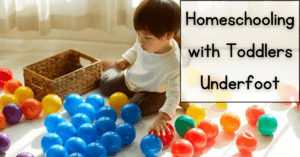I have always wanted to homeschool my future kiddos. Although I enjoyed many aspects of my public school education, I realized that the classroom couldn’t individualize the lesson plans and curriculum for each unique child. I remember being called out into the hallway in second grade along with two classmates. We were soon told that we were more advanced than the rest of our class and would be joining a different class for reading each day. (There were three classes for each grade level in my elementary school.) Later on in seventh grade, I was assigned to a combined seventh and eighth grade math class so that we could advance quicker through the curriculum.

Knowing that this was a benefit of the size of the schools I attended and that most kids don’t have these opportunities, I decided that I wanted to homeschool my future kids. Whether they were advanced learners, average students, or took their time understanding new concepts, I knew that I’d have more time available to dedicate to their individual learning than a public school teacher that needed to teach 20-30 students and couldn’t personalize everything to one or two kids.
I definitely don’t fault the teachers for this. If I had that many kids in a classroom, I wouldn’t be able to individualize my lessons either!
Although I hadn’t been exposed to homeschooling, I knew it was the option that I wanted to choose for my kids. Not only could I teach them based on their learning level, but I could add more hands-on learning experiences. Whenever I spoke about homeschooling, I said that I wanted to teach about the pyramids and then visit them.
Getting Started Homeschooling
Just before my daughter turned three, I started to research homeschooling – where to start. I wanted to know how homeschooling works, what homeschooling looks like, how homeschooling affects child development, what homeschool curriculum is best, and as much other information as I could find. I stumbled across a blog series curated by Blessed Homeschool – Homeschooling in 50 States – it was so informative and I learned how highly regulated New York state is when compared to other states. From there I followed a rabbit trail (not this blog, though I discovered it, too!) and eventually found a blog post on how to name your homeschool.
Naming your homeschool is not required in New York, but I loved the idea of it! If our homeschool had a name, it would feel more real, more legitimate, more like something that was no longer a fantasy but an actuality. I told my hubby and he also liked the idea so he helped me sort through ideas to name our school. We named it and I immediately set up an email account for it so I could keep all of my homeschooling emails and resources in one place.
Hopefully this blog will give you an idea of everything that came later, each small step I took toward learning what would work for our family, each of the successes and frustrations along the way, and how I started to gain confidence as a homeschool mama. At the moment, we’ve homeschooled from September through June. It’s now July, a new school year, so we’ve officially made it through the first year!
In my next blog post, I’m excited to review how the year went and the resources we’ve used. Stay tuned!
Thanks for joining us today In Our Homeschool.
Disclosure: As an Amazon Associate I earn from qualifying purchases. This post may include affiliate links which means I may earn commissions for purchases made while using my link.




This Post Has One Comment
Pingback: How to Start Homeschooling - In Our Homeschool